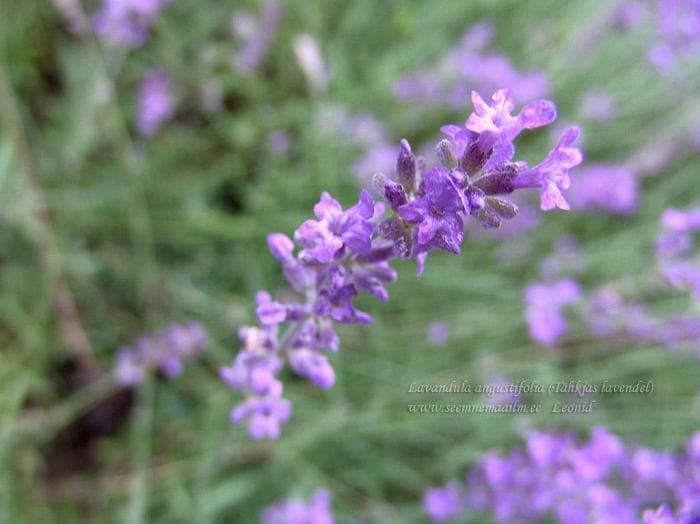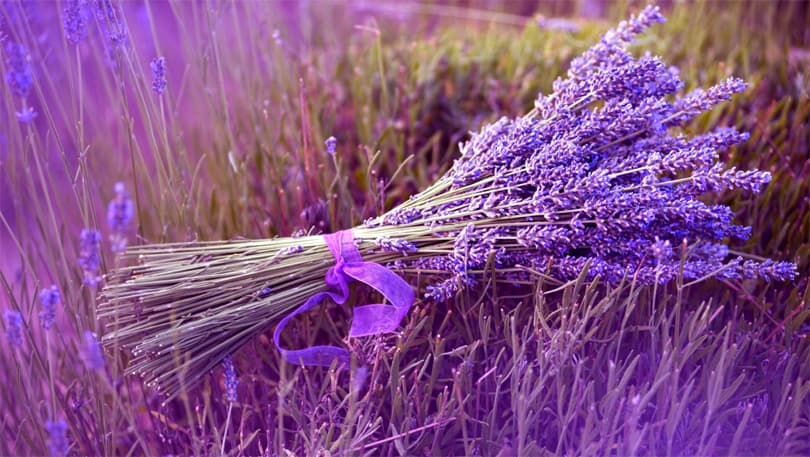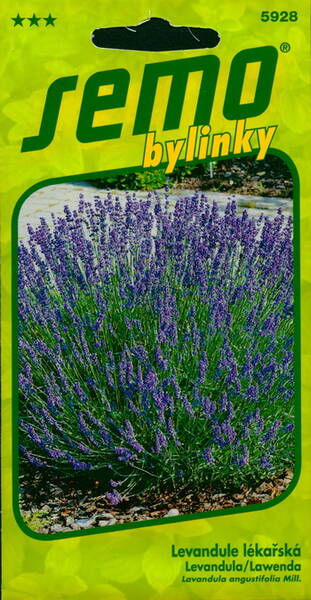A perennial with an amazing aroma!
Plant height 30-50 cm. The leaves are linear, silvery-greenish-gray, with delicate pubescence. The flowers are small, collected in interrupted spike-shaped inflorescences, lavender. Blooms in July-August.
Used for rocky slides, to create a fragrant border framing flower beds. Grows well in pots.
Agricultural technology.
The plant prefers a sunny place, dry, moderately fertile soils. Sowing for seedlings is carried out in the second half of January - February to a depth of 3 mm.
The planting container is placed for 14 days in a refrigerator at a temperature of +5°C. Then the seeds germinate at a temperature of +15+21°C for a month. When the seedlings grow up, they dive according to the 5x5 cm pattern. In May, the seedlings are planted in a permanent place.

* True lavender - Lavandula angustifolia = Lavandula officinalis = Lavandula vera.
Origin: Southern Europe.
Perennial semi-shrub with a woody fibrous root, reaching two meters in length, and numerous shoots up to 60 cm high, woody in the lower part. The flowers are small, bluish-lilac or blue. Smells very nice. Blooms in July - August.
Location: grows well in a sunny, warm (even hot) place.
Soil: dry, fresh, well-permeable, gravel or sandy-clay, moderately nutritious, containing lime.
Lavender cannot grow on heavy clay soils with high acidity and high-standing water tables.
The soil mixture is prepared as light and fertile: from leafy soil, humus and sand, taken in a ratio of 3: 2: 1, adding full mineral fertilizer to it at the rate of 20 g per hole.
Landing: plants are planted at a distance of 30-40 cm from each other.
Care: cut regularly in the spring. In dry weather, water is abundant.
In Estonian conditions, it must be securely covered for the winter (spruce branches and pine needles are suitable). If nevertheless, the aerial part is frozen, then it is cut off, and the plant, as a rule, is restored. The bushes are regularly rejuvenated with the same pruning so that they do not become bare from below.
Seeds require stratification for 30-40 days at +5°C.
Sow seedlings in late February - early March to a depth of 3 mm. Seeds germinate in the light at a temperature of +15+21°C.
When the seedlings grow up, they are planted in 5 cm increments. In May, the seedlings are planted in a permanent place.
You can sow seeds on the ridges in the fall, at the end of October. Shoots at the same time appear in the spring, at the end of May.
For reproduction by dividing the bush in autumn, the plants are cut to a height of 8-10 cm and spud with earth, carefully filling the space between the stems. In the spring, the earth is still poured into the bushes.
During the summer, lavender produces abundant shoots that take root well. In autumn, the bush is dug up and divided.
Another easy way to propagate lavender is by layering. To do this, in the spring, 2-3 shoots are carefully bent and placed in a shallow (3-5 cm) groove, pinned, covered with soil and watered. During the summer, the ground here should be slightly damp. Usually, next spring, the shoot can already live on its own and is cut off from the mother bush.
Application: on terraces, in gardens with fragrant herbs.
Partners: shrubs or semi-shrubs that love dry soils. Grows well with roses.

True lavender. Bot. syn.: Lavandula officinalis Chaix., Lavandula delphinensis Jord ex Billot, Lavandula spica L., Lavandula vera DC.
* English lavender (Lavandula angustifolia) can also be grown at home if you have a south window, or better, a bright glazed loggia.
Can be grown in the summer and in a balcony box. You can plant in any universal soil for indoor plants, adding to it about a third of the volume of fine limestone rubble (in extreme cases, a few limestone stones placed on the bottom of the pot and on top of the soil will do).
Do not get carried away with watering, let the soil dry out a little between waterings.
In winter, rest is desirable for the plant, even small negative temperatures are not terrible, however, it will most likely freeze out on an open balcony. Can overwinter on a cool windowsill.
The main thing is light!
Pear jam with grapes and lavender.
Peel ripe firm pears, remove the core and cut into thick slices. Sort the grapes, rinse and drain in a colander. Finely grate the zest from the lemon and squeeze the juice out of the pulp.
Place the pears and grapes in a jam pot, add sugar and lemon juice. Place the jam on low heat, bring to a boil and cook for 10 minutes. Then remove from the stove and cool for 2 hours. Return the jam to the heat and cook for another 10 minutes. Then cool the jam again for 2 hours.
Bring the jam to a boil for the third time, add lavender, lemon zest and cook for another 10 minutes. After this, remove the lavender sprigs, pour the boiling jam into sterilized jars. Seal tightly, turn the jars upside down and, wrapped in towels, leave to cool.
Grapes (dark varieties) - 500 g, pears - 1 kg, lavender (dried) - 3 g, lemon (juice and zest) - 1 pc., sugar - 300 g.
Fruit in lavender syrup.
Put sugar and lavender in a saucepan. Add 300 ml of water, bring to a boil, boil over high heat for 5 minutes. Add honey and boil for another 2 minutes. Remove from heat.
Put the fruit in a fireproof bowl, strain the syrup through a sieve onto the fruit. Let cool. Put in the refrigerator overnight. Transfer the fruit to rosettes, serve with Greek yogurt or sour cream.
Sugar - 200 g, lavender (fresh leaves) - 1 tbsp., honey (clear) - 3 tbsp., nectarines (slices) - 4 pcs., plums (cut in half and pitted) - 6 pcs., strawberries (cut in half) - 250 g, Greek yogurt or sour cream for serving.
Pumpkin soup with cream and lavender.
Cut the pumpkin pulp and onion into cubes. Heat vegetable oil in a saucepan, simmer the onion, pumpkin and rosemary in it. Pour in the broth, cover the vegetables with a lid and cook for 20 minutes. Puree the pumpkin, onion and rosemary in the broth, pouring in the cream. Boil the soup, add lemon juice, season with salt, pepper and a pinch of sugar, stir. Melt the remaining sugar in a small saucepan. Place the lavender on baking paper and pour half of the melted sugar over it. Turn the flowers over and pour the remaining liquid over them. Pour the soup into deep bowls and garnish with lavender.
Pumpkin (pulp) - 500 g, vegetable broth - 500 ml, cream - 200 ml, onion - 1 pc., vegetable oil - 2 tbsp., rosemary (chopped) - 0.5 tsp., juice of one lemon, sugar - 3 tbsp., lavender (fresh sprigs with flowers) - 8 pcs., salt and ground black pepper - to taste.
Lavender-scented potatoes.
Preheat the oven to +220 °C. Wash the potatoes, dry them and cut them in half. Place the potatoes together with the remaining ingredients in a large bowl and mix well. Place the potatoes in a single layer on a baking sheet and place in a preheated oven for 20 minutes. Serve the aromatic potatoes hot as a separate dish or as a side dish for meat or fish.
Young small potatoes - 600 g, olive oil - 1 tbsp, lavender (dried) - 1.5 tsp, salt - 0.25 tsp, ground black pepper - 0.25 tsp.
Lamb with lavender.
This is one of the easiest, most inexpensive and delicious ways to cook lamb. The sweet aroma and juiciness of the meat are preserved thanks to quick baking in a very hot oven.
Finely chop the lavender or grind it into powder, mix with cottage cheese and crumbs. Press the mixture with a spatula and spread it on the fatty side of the lamb. Place the lamb in a baking dish and bake for 30 minutes (or a little longer if you don't like your lamb rare).
Cut the lamb between the bones and serve. It's delicious served with sliced pineapple.
Lamb neck - 1 kg, lavender - 1 tsp, cottage cheese with garlic - 75 g, brown bread crumbs - 50 g, salt and ground black pepper - to taste.
Tea with lavender and chamomile flowers.
Crush dry lavender petals and chamomile flowers in a mortar with a wooden pestle. Pour the resulting flower infusion into a porcelain teapot, after rinsing it with boiling water. Pour boiling water over the flowers and cover the teapot with a lid. Brew for 10-12 minutes and pour through a strainer. Add sugar to the cups.
Lavender (petals) - 1 tsp, chamomile flowers - 1 tbsp, water - 500 ml, sugar - to taste.
Raf coffee with lavender.
The classic raf coffee recipe uses vanilla as a seasoning, but lavender is an excellent substitute here.
Brew coffee in your usual way. Grind the sugar and lavender until powdered. Add the resulting powder to the coffee and stir. Pour in the cream and heat the drink without bringing it to a boil. Beat the coffee in a blender (or with a cappuccino maker) until a stable foam forms. Pour the raf coffee into a glass and serve immediately.
Water - 100 ml, cream (10%) - 100 ml, natural ground coffee - 1.5 tsp, lavender - 0.5 tsp, sugar - 1 tsp.
Lavender lemonade.
Pour water into a saucepan, add sugar and bring to a boil. Add lavender flowers and mint, cook over low heat, stirring constantly, until the sugar is completely dissolved. Remove the syrup from the heat, cool and strain. Squeeze the juice from the lemons. Pour ice water into the cooled syrup and add lemon juice. Pour the lemonade into glasses, add ice cubes and serve, garnished with a mint leaf.
Water - 2 cups, sugar - 1 cup, lavender (dry or fresh flowers) - 2 tsp, lemon balm (fresh) - 2 tbsp, lemon - 5 pcs., mineral water (ice) - 300 ml, ice.
Tea liqueur with lavender.
Mix vodka, vermouth, white tea and lavender in a jar of a suitable volume, stir well. Close the jar tightly and leave to infuse in a dark, cool place for up to 7 days, until the liquid acquires a bright taste and aroma of lavender. Strain through a sieve or several layers of gauze (do not squeeze!). Filter through cotton wool or coffee filters. Add simple syrup to the infusion, pour into bottles and store in a dark cupboard for up to 1 year. Keep for at least 2 weeks before serving.
Vodka - 250 ml, dry vermouth (18%) - 500 ml, white leaf tea - 25 g, dried lavender flowers - 25 g, simple syrup (sugar: water 1:1) - 200-250 ml.
Lavender liqueur with gin.
Mix gin, dried lavender flowers, vanilla and honey in a container of a suitable volume, stir well. Close the container tightly and leave in a dark, cool place for 3-7 days, until the aroma of the tincture acquires a bright taste and aroma of lavender. After that, strain the liqueur through a sieve, without squeezing out the solid residue. If necessary, filter through cotton wool or coffee filters. Pour the liqueur into bottles and store in a cool, dark cupboard for no more than 1 year. Keep for at least 1 week before use. Gin - 750 ml, dried lavender flowers - 25 g, vanilla - 1 pod, honey - 200-250 ml.












